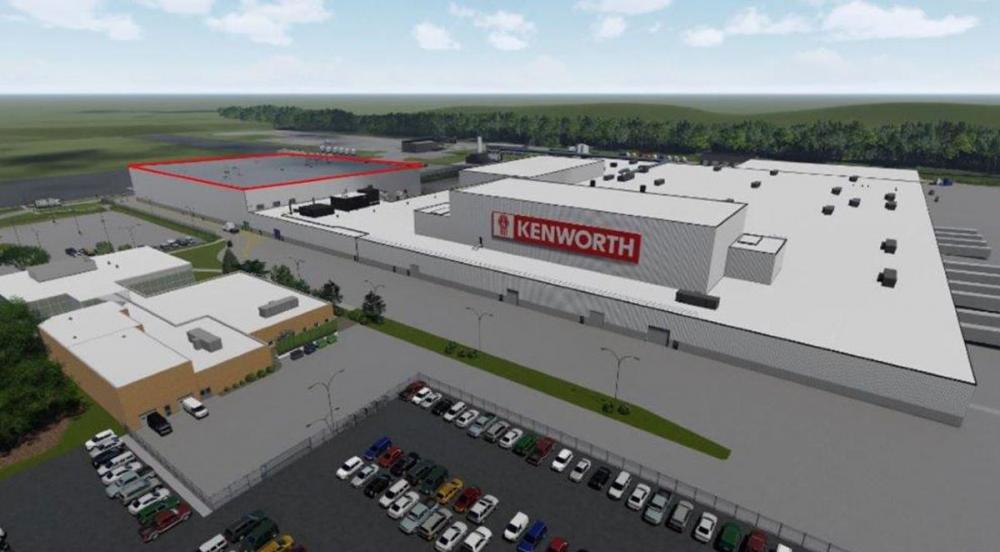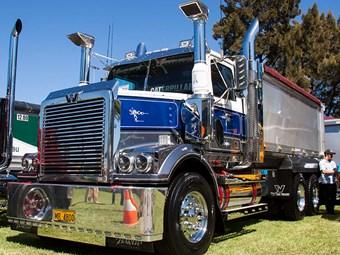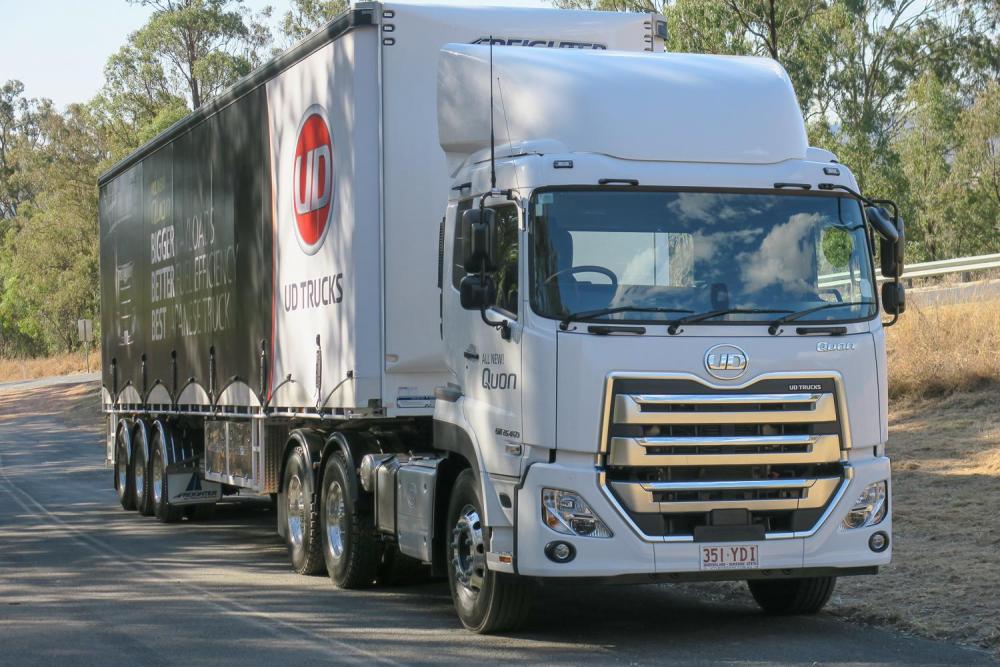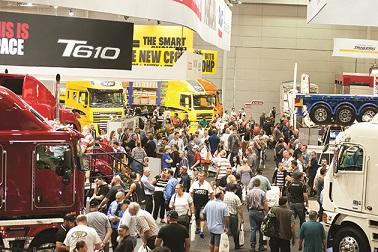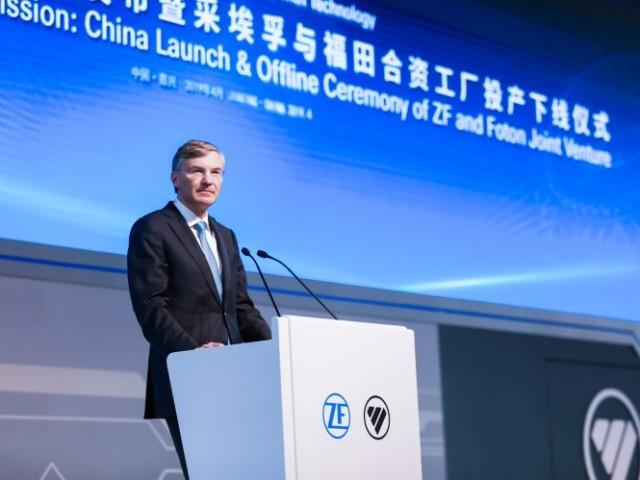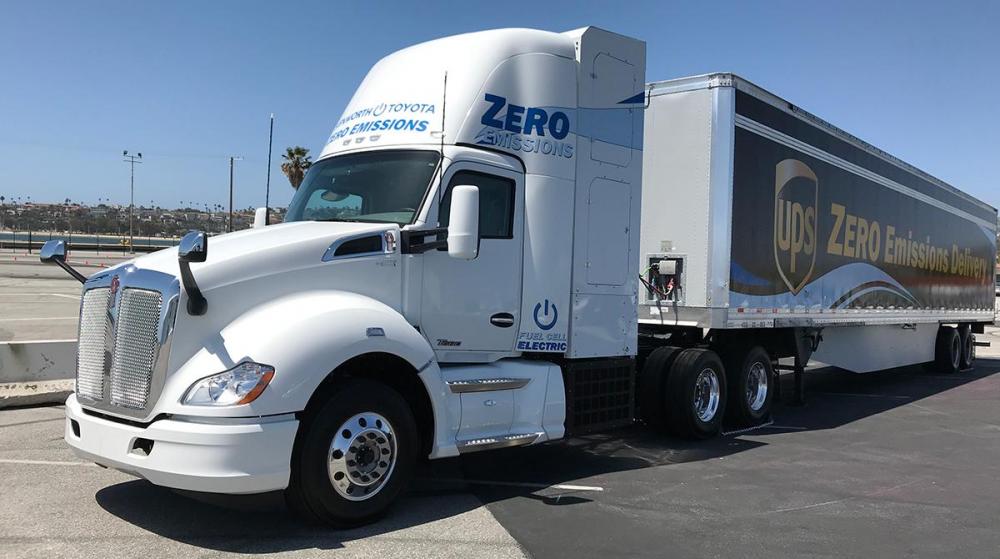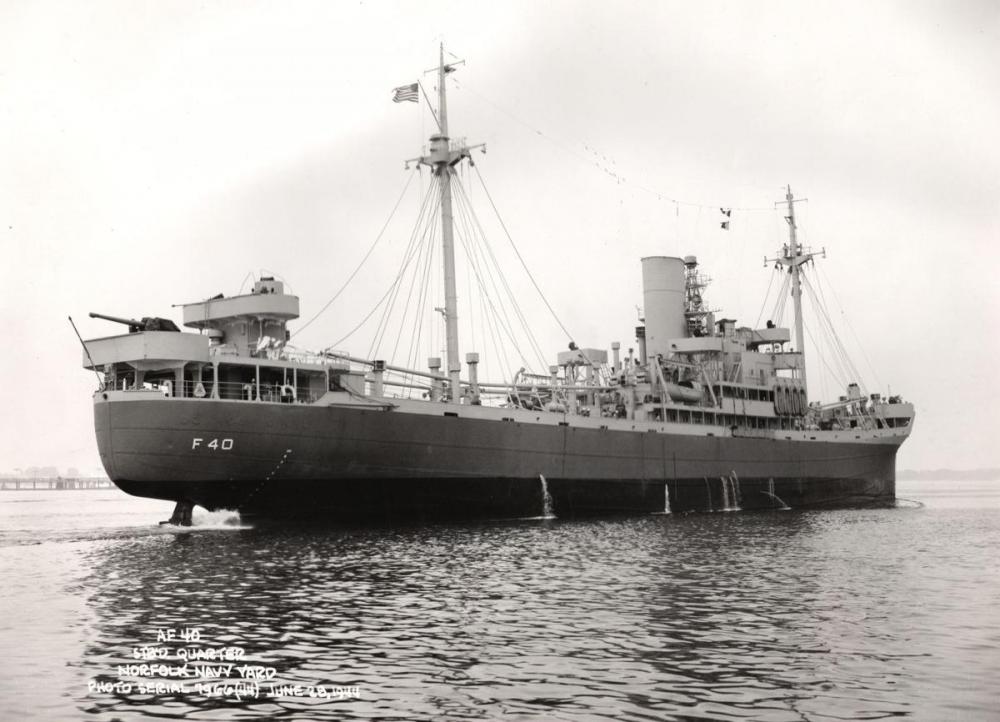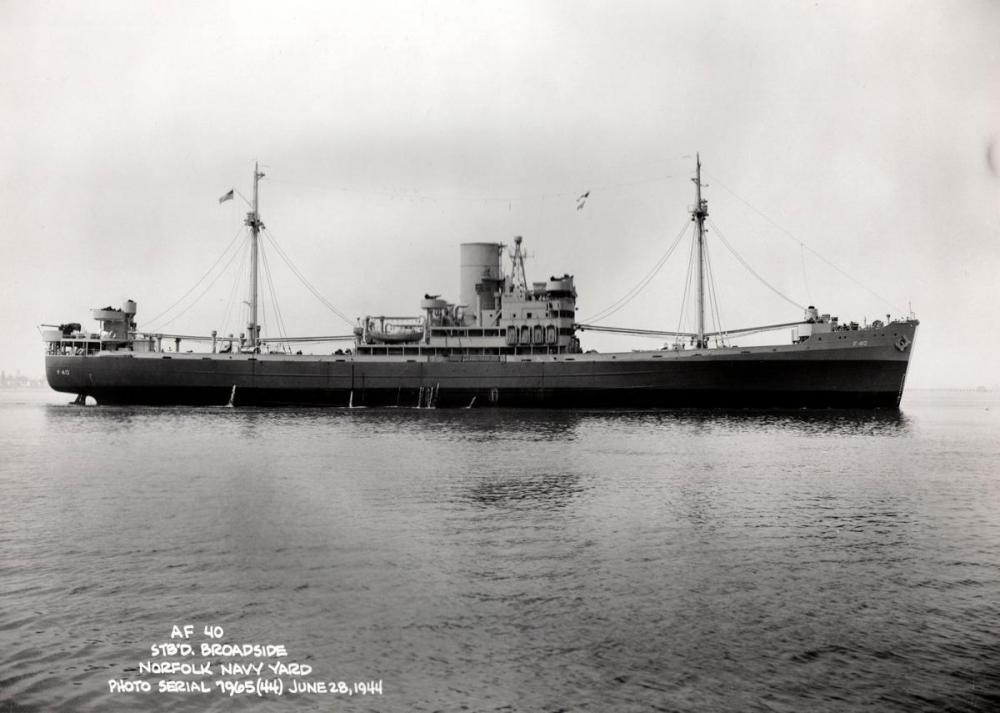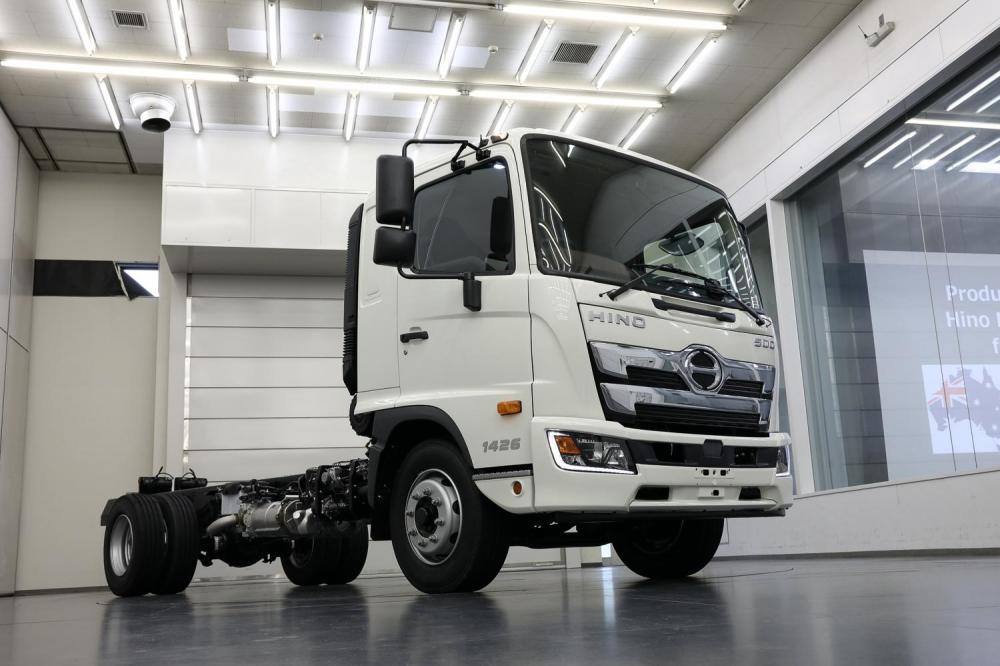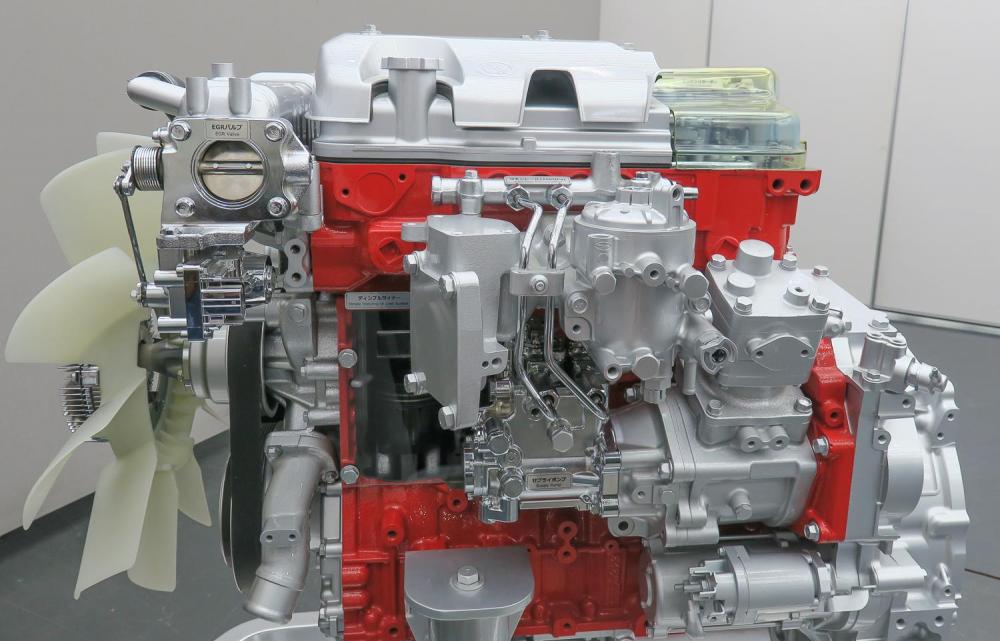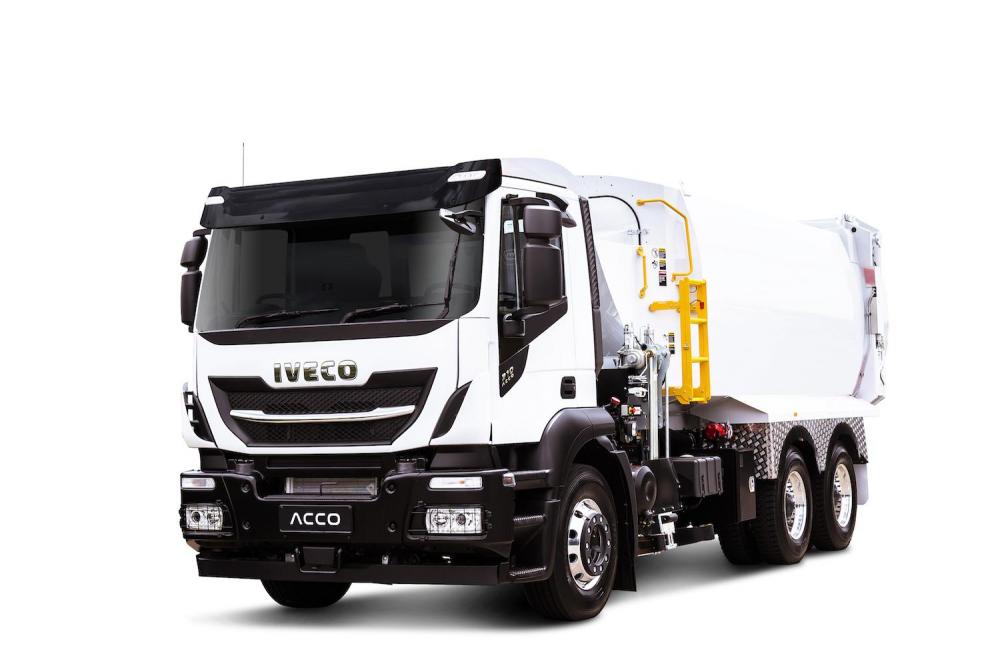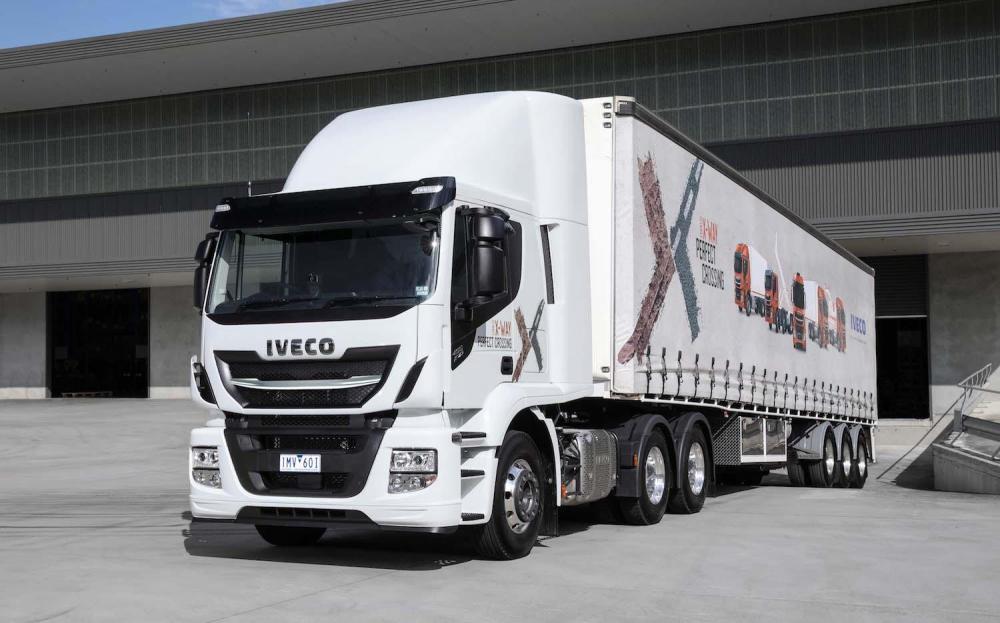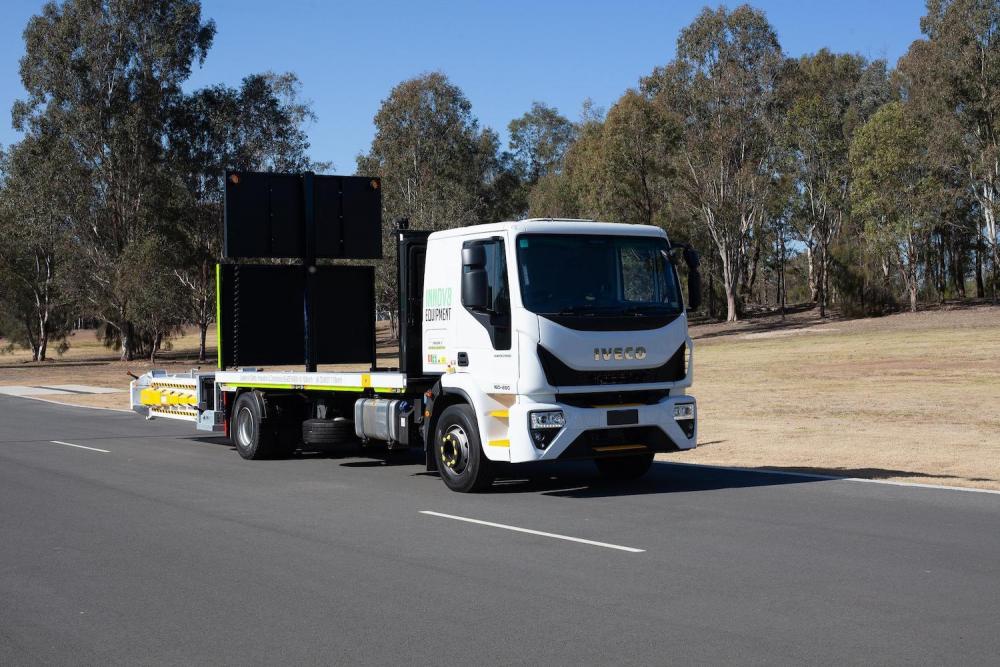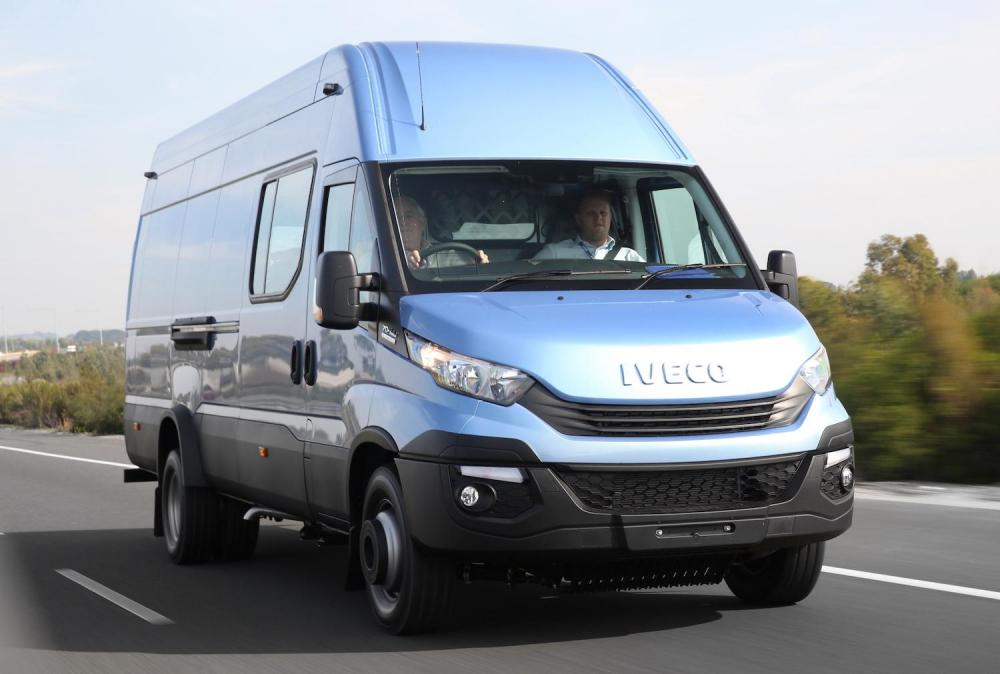
kscarbel2
Moderator-
Posts
18,855 -
Joined
-
Days Won
114
Content Type
Profiles
Forums
Gallery
Events
Blogs
BMT Wiki
Collections
Store
Everything posted by kscarbel2
-
Transport Topics / April 24, 2019 CHILLICOTHE, Ohio — Kenworth Truck Co. on April 24 broke ground to officially start construction on a $140 million, 120,000-square-foot paint facility addition to its Class 8 truck assembly plant. Kenworth will construct the facility, expected to open in 2021, adjacent to the current plant. The expansion represents a nearly 25% increase to the current 502,000-square-foot plant, which is located on 120 acres 50 miles south of Columbus. The facility will utilize the latest technologies to increase paint capacity by 50% while enhancing the plant’s product quality and environmental stewardship programs. Advanced technologies integrated into the facility include robotic paint application systems and the latest in emissions-control systems. “Our investment in this outstanding new facility highlights Kenworth’s focus on leveraging technology to continually enhance the quality of the products we provide our customers, said Mike Dozier, Kenworth general manager and Paccar Inc. vice president, “while also reinforcing Kenworth’s commitment to the production of industry-leading Class 8 trucks by the more than 2,000 outstanding employees at our Chillicothe plant.” Complementing the investment in the new Chillicothe paint facility, and scheduled for completion this summer, is the installation of a $33 million robotic cab assembly cell. The cell will occupy 40,000 square feet on the existing production floor and support the continued market share growth of Kenworth’s T680, T880 and W990 models. .
-
Jon Harris, The Morning Call / April 24, 2019 While Mack’s deliveries rose in the first quarter, its order intake was down big. In the quarter, Mack took in some 3,200 orders, down 67% from the same period one year ago. Mack’s market share in North America continued to drop in the first quarter, hitting 5.5%. Heffner noted that the overall heavy truck market has grown primarily in the long-haul segment, which Mack hopes to grab a larger portion of the long-haul segment as the year progresses on the strength of the Anthem.
-
Same tranny..........https://www.bigmacktrucks.com/topic/56758-eaton-displays-retarder-equipped-next-generation-endurant-transmission-at-shanghai-auto-show/ On another note, I asked Eaton for years to once more offer a transmission for the global market set up for a retarder installation, but they arrogantly refused. Eaton hasn't offered a retarder-capable global market transmission since the fully synchronized 16-speed RTS(O)-xx316A. I don't know if the US market will see it though. Hard to beat the Voith retarder.
-
Ford's $500M investment in Rivian to yield new electric vehicle Michael Martinez, Automotive News / April 24, 2019 DETROIT -- Ford Motor Co., in another move to shore up its electrification efforts, on Wednesday said it was investing $500 million in electric vehicle startup Rivian and plans to build a battery EV using Rivian's flexible skateboard platform. The move comes weeks after talks between Rivian and General Motors reportedly broke down. GM reportedly was interested in becoming an equity investor in Rivian, much like Amazon, which invested $700 million in the startup in February. For Ford, the deal secures another ally to manage costs and development in a hyper-competitive space where it has so far lagged behind much of the competition. While rivals including GM and Tesla have introduced battery-powered vehicles, Ford's first long-range battery EV -- a Mustang-inspired crossover -- won't hit showrooms until 2020. It's also planning a battery-powered F-150 pickup. Ford is also in discussions with Volkswagen about sharing an EV platform. Ford CEO Jim Hackett on Wednesday said the Rivian investment "does not interfere" with any potential deal with VW. "This is a specific platform that helps us in an area we weren't considering with others," Hackett told reporters on a conference call. Ford executives declined to say what type of vehicle the company would develop on Rivian's skateboard platform, where it would be built or when it would go on sale. They said it would not be one of the two battery EVs Ford has already announced. Hackett said the Rivian investment was in addition to Ford's $11 billion financial commitment to electrifying its lineup through 2022. "Ford's investment in Rivian is a smart one," Michelle Krebs, executive analyst at Autotrader, said in a statement. "Rivian leverages Ford's leadership, expertise and massive volume in pickup trucks as well as its vast distribution network. The Amazon investment in the Rivian mix may well give Ford an in with the delivery services, possibly with electric cargo vans." Rivian, which has shown concept versions of an electric pickup and SUV, will remain an independent company, and the investment is subject to regulatory approval. Joe Hinrichs, Ford's president of automotive, will join Rivian's seven-member board. Rivian's founder and CEO, RJ Scaringe, said the startup plans a "broad portfolio" of vehicles on its skateboard architecture, some of which might directly compete with Ford's EVs. But he said vehicles it develops with Ford will be distinct, with Rivian focused on higher-priced performance models in the active lifestyle space. "What we do with Ford will be different than that," Scaringe said. Scaringe said Rivian could partner with other companies, although its current focus would be on building the relationships with its existing partners. Hinrichs said the deal allows Ford to save money and speed up the arrival of its upcoming crossover EV, and he left open the possibility that the partnership could broaden beyond one vehicle, saying this was the "first of many pieces of news" he hoped both companies would share.
-
Nissan Diesel has seen better days.
-
Freightliner Columbia 112 Vocational Twin-Steer
kscarbel2 replied to kscarbel2's topic in Trucking News
-
Owner-Driver / April 12, 2019 The 2019 Western Star Trucks Show n Shine will take place in Penrith in November Penske Commercial Vehicles will be hosting the 2019 Western Star Trucks Show n Shine in the grounds of the Museum of Fire in Penrith, NSW, on Sunday, November 3. The Museum of Fire is well known in truck show circles; it’s also the venue for the annual Penrith Working Truck Show as well as the annual Sydney Classic and Antique Truck Show. This will be the first Western Star Show n Shine event to be held in NSW. Penske says it will be a chance for Western Star owners to polish and display their much-loved trucks. Last year’s event held in Toowoomba saw North Queensland Truck and Machinery Movement’s ‘Phatcat’ 4800 take out truck of the show, with KS Easter’s 200th truck taking home the title in 2017 at the Mt Cotton Training Centre west of Brisbane. Penske says the 2019 event will again feature a host of prizes across several categories. "After speaking with customers and our dealer network, the decision was taken to move the show and shine to Sydney’s west," says Kevin Dennis, managing director of Penske Commercial Vehicles. "Our last two events were very successful with a great turnout of Western Star faithful and their friends and families, and we are sure that this year will be even better! "In addition to our national customers who travelled from far and wide the last two years and will do so again, we are also looking forward to spending the day with our NSW customers who didn’t make the trip north of the border the last few years." Registrations are due to be open soon. For further information about the event, visit www.facebook.com/WesternStarTrucksAustralia .
-
Diesel News Australia / April 2019 The Australian requirements for a prime mover on Aussie roads are unlike those anywhere else in the world. We are also a relatively small prime mover market in the greater scheme of things, but every truck manufacturer likes to have a photo in their boardroom of their prime mover hauling a road train on a dusty red road in Australia’s outback. It infers ruggedness, durability and strength. They have all had a crack at the market and have succeeded in one way or another. For the Japanese, however, the results have been patchy at best. The domestic Japanese heavy duty market does exist, but the heavy duty rigid is the dominant force at the heavy end of the weight range. There is also not much of a sleeper cabin tradition in Japan, most are fitted with something we would regard as an enhanced day cab. All of the Japanese truck makers have offered a prime mover to the heavy duty market which has ticked some of the boxes in terms of Aussie requirements, but none have hit the mark squarely enough to have an impact. Engines have not had enough power or torque, wheelbases have not been suitable to get maximum benefit in GCM terms. The marriage of the Roadranger gearbox and Japanese engine has not been one made in heaven, functional but not great. Cabins have been ordinary and often cramped. The trucks have been adequate for the task, but were up against the best North America and Europe could offer, and coming a distant third. On the highway the UD Quon does demonstrate its strengths. This is a UD truck, so it sits down well on the road and gives the driver a relatively firm ride. The difference between the older models and this one become clear when manoeuvring. The steering is smooth positive and light, the influence of Swedish engineers in the steering system design. The engine brake is a real engine brake, this is not a butterfly valve changing the engine note, this is a compression brake. At the top of a long descent this driver clicked the automated manual transmission (AMT) over to manual, selected a suitable gear and engaged the engine brake. The ability of the engine brake to hold back a fully loaded semi on a steepish grade was surprising. There are four stages available on the engine brake to give the driver some more control over speed of descent and engine revs. The brake blending system is also in the European mode, touching the foot brake engages the exhaust brake, then the engine brake and then the service brakes, depending on how far the driver pushes the pedal when looking to slow the truck. The Escot AMT shows its European pedigree by disengaging the clutch and allowing the engine to idle when the truck does not need engine power to maintain 100 km/h. This coasting feature is another of the modern fuel saving features coming into the Japanese truck sphere. Hill start assist is also included to make it easier when taking off on a slope. This is one of those truck tests where the expectation of anything out of ordinary is quite low. This looks like the GW we have seen over the years. the familiar UD prime mover shape remains largely unchanged apart from features like the front grille and the headlights. These differences become much more obvious when the old and new are parked side by side. Even climbing into the cab, the basic layout has changed little. Most of the controls, storage and so on, are in a familiar place. It’s when you get out on the road that the impact of the changes made really hit home. The ride is excellent, the steering spot-on, the transmission is virtually faultless. The penny drops, this is a new truck. Then less obvious features like the coasting/rolling feature or the Traffic Eye come into play. The ACC makes life very easy for the driver, as long as it’s used properly. The engine brake also improves the driving experience, and if there were any doubts about the efficacy of this 11 litre engine in this environment, they are soon forgotten when the engine gets stuck in at the foot of a grade. The truck starts to communicate with you, giving you a percentage score on your driving behavior. It will also make recommendations, like suggesting the truck has been sitting at idle for too long. This is not the very basic UD prime mover from twenty years ago, this is a modern state-of-the-art truck, disguised as a Japanese one. .
-
Prime Mover Magazine / April 23, 2019 The sheer scale of original equipment manufacturers that assemble at the Brisbane Truck Show makes it a world class event and for many in the commercial road transport industry it represents a mecca in which to view and engage with the latest vehicles, newest equipment and advances in technology made available in seminars and shared information sessions. Dating back to 1968, the biennial Brisbane Truck Show on 16-19 May occasions a pilgrimage to Southeast Queensland for many in road transport where four days of product showcases will offer a glimpse into the near future of the industry. Located at the Brisbane Convention & Exhibition Centre for the fifth time, the event is supported by the Queensland Government and Brisbane City Council. South Bank Parklands will again help to co-ordinate the extension of the show into the entertainment and restaurant precinct providing it with additional atmosphere in the evenings. Part of this transformation involves the launch of the South Bank Roadhouse. The Penske Group returns this year, with offerings from the latest in its Western Star, Detroit and MAN product range. Daysworth has confirmed it will display its next generation Diamond Reo while both SEA Electric and Foton Motor are on board with the latest advances in technology for light-heavy and heavy vehicles. The general public will also get a glimpse of commercial vehicles currently undergoing evaluations long before much anticipated launches in the market. Brisbane-based manufacturer Mack is widely tipped to debut its new Anthem, which until now has made rare appearances at events largely reserved for select media. PACCAR will showcase the latest in Kenworth technology including the remodelled T360 and the new T410. For many attendees the Brisbane Truck Show is the first opportunity to take in the test models of the Freightliner Cascadia ahead of its arrival next year. Mercedes-Benz are expected to display its new SoloStar concept, a roomy interior with a lounge set-up boasting a 900mm bunk, making it the biggest bed on the market. There’s also speculation that the mirrorless, partly autonomous Mercedes-Benz Actros on show at Hannover last year will also be part of its display in Brisbane. One of the highlights at this year’s event will be the National Apprentice Challenge, which has attracted a record amount of entries from all parts of the country according to Steve Power, Heavy Vehicle Industry Association National Manager Communications. “It’s quite a dynamic audience driven event with commentary and interviews going on over the whole four days of the show,” he says. “Heats take about an hour and a half and the event will culminate with a final on the Sunday.” Sponsored this year by IVECO, the National Apprentice Challenge will feature three identical vehicles with faults pre-programmed into them. Each team is required to solve the issue in a race against the clock. The contest is run with help from Queensland TAFE SkillsTech, as part of an initiative to develop talent and nurture career paths within the industry. Through a schools-to-industry program, 800 students are bussed in from high schools from around the region and put through a series of seminars from a variety of exhibitors to showcase career paths. This has led to the creation of a Jobs Hub which includes a Jobs Exchange where employees and employers can be matched across over 200 jobs. “This initiative is about promoting our industry more broadly and the career paths that are available,” says Steve. “Typically people think you have to be a driver or mechanic to be involved. That’s not the case. The new Jobs Hub highlights the broad range of career paths available across the different sectors of the industry and the possibilities of working internationally and in leadership positions for major companies.” The Job Exchange allows attendees to submit their resumes and get matched, appropriate to their skills and experience, with jobs online and real employers in the flesh. Steve equates it to speed dating. “I think the program is going to be a real highlight. It will generate a lot of interest within and outside of the industry,” he says. The National Road Transport Association will hold its annual NatRoad Conference in conjunction with the Brisbane Truck Show on 15 May. This year’s main points include technology innovation and safety; improving business health by adopting forward-looking processes and systems; a focused approach to building a diverse workforce and making the industry a career choice for a younger generation; sustainability and keeping abreast of industry news and changes to rules and regulation. Another feature of the event is the Insight Centre sponsored by KPMG who is currently conducting a major study on the road transport industry footprint covering manufacturing, sales, maintenance, service and distribution on behalf of the HVIA. The Australian Trucking Association, NatRoad and the Queensland Trucking Association have all confirmed that they will be running sessions at the Insight Centre over one of the four days. These presentations, according to Steve, will provide real value for visitors with helpful information about managing internal finances, fatigue management and making improvements to their business. Another of the sessions will be dedicated to navigating the National Heavy Vehicle Regulator portal from an operator’s point of view. “Like any event what we’re trying to do is make every visitor’s experience even stronger,” he says. “It’s going to be a useful resource and give them an extra bang for their buck.” Scania has confirmed it will have a New Truck Generation V8 flagship, a Scania XT tipper, a G-series prime mover and two P-series rigids as part of their exhibit. In line with Scania’s commitment to innovative sustainability solutions one of the rigids is dedicated to running on alternative fuels. Drake Collectibles celebrates its tenth anniversary at the event. The celebrations will include original tooling from their first ever model, merchandise, new diecast product announcements and Q&A sessions on how the models are created. The Drake Group will showcase the premium finish and high quality of its Drake and O’Phee heavy haulage trailers. JOST Australia will unveil its latest development in towing hitch technology with the help of its ROCKINGER range. Part of its showcase will involve the RO*50E towing hitch which it claims permits gentle coupling even at difficult drawbar eye angles. ROCKINGER has also developed a camera which acts as a driver’s third eye whereby the driver is able to see the exact position of the drawbar eye and can engage the coupling in a targeted manner minus visual misalignment. Under the umbrella of Australian Heavy Vehicle Industry Week, the Brisbane Truck Show will continue to announce additional keynote presentations, forums and entertainment in the following weeks. .
-
At the end of 2016, ZF entered into two joint ventures with Chinese truckmaker Foton to produce and sell commercial truck transmissions. The partners have now opened a production plant in Jiaxing, to the south of Shanghai. The companies will focus primarily on the production of automated manual transmissions (AMTs) for heavy and light commercial trucks. The joint venture, known as ZF Foton HCV Automated Transmissions (Jiaxing) Co., Ltd., in which ZF holds a 51% share, is focused on heavy commercial trucks. The main objectives of the JV is the production and marketing in China of ZF’s TraXon transmission system. The TraXon system will be integrated into Foton heavy trucks. “In China, the demand for automated transmission systems for light and heavy commercial trucks is growing strongly,” explains Wolf-Henning Scheider, Chief Executive Officer of ZF Friedrichshafen AG. “Together with our partner Foton, we will produce our latest transmission technology in China and thus offer our local customers more efficiency, comfort and safety.” Compared to manual transmissions, the TraXon AMT transmission reduces fleet average fuel consumption by up to 5 percent. Heyi Xu, CEO of Foton’s parent company BAIC Group, added: “This joint venture sees the joined hands of two industry leaders. It speaks for the product innovation and business capabilities of BAIC, and ZF global leadership in transmission products and manufacturing. Both parties will leverage on their respective technology and strengths, form a modular and standard production platform, in order to produce cutting-edge, efficient and intelligent transmission products for the world. We will provide Chinese customers of commercial vehicles the desired world-class products, leading the development of the sector.” ZF Foton HCV Automated Transmissions (Jiaxing) Co., Ltd. began production today. Production capacity in Jiaxing will be expanded successively and this is where ZF will produce the TraXon 12-speed transmission for the Chinese market. With an efficiency factor of 99.7 percent, TraXon is the most efficient commercial vehicle transmission on the market today and can be combined with additional functions, ensuring its viability for future market developments. These functions include, for example, ZF’s predictive gearshift strategy PreVision GPS. With improved use of the rolling function this can further increase efficiency. The off-road and rock-free functions can improve the transmission performance during winter months, or in special vehicle applications. Moreover, ZF Foton HCV will offer the TraXon transmission system together with the Intarder [retarder] transmission brake. This effectively brakes heavy trucks without strain or wear on the service brakes. The Intarder can increase safety and extend the service interval, thus offering additional cost advantages in practice. Production of the Intarder will also take place in Jiaxing. A second joint venture, Foton ZF LCV Automated Transmissions (Jiaxing) Co., Ltd.,in which ZF holds a 40-percent share, produces transmissions for light commercial trucks in Jiaxing for the Chinese market. .
-
https://paccarpowertrain.com/#section-integrated-powertrain
-
What the U.S. should learn from Britain’s dying navy
kscarbel2 replied to kscarbel2's topic in Odds and Ends
British Army decides to reduce its tank fleet size by a third Defense Blog / April 20, 2019 The UK army’s fleet of Challenger 2 main battle tanks is to be stripped by a third, according to The Times. According to the sensationalist media report, the British Army is planning to revamp only 148 of its 227 Challenger 2 tanks because of cost constraints. Also notes that the remaining main battle tanks would be used for spare parts, though it said that some tanks could be patched up for deployment in an emergency. This statement was a real shock to a number of military experts who voiced concerns over plans to cut British tank fleet. The “new” British Army would have 87 times fewer tanks compared with Russia. In the decade after the end of the Cold War, Great Britain lost its tanks production and can now lose most of its tank fleet, which in 1991 consisted of nearly 800 combat vehicles. Challenger 2 is a heavily armoured, highly mobile Main Battle Tank, designed for use in the direct fire zone. Its primary role is to destroy or neutralize armour. However, it has the ability to engage both hard and soft targets and can operate across a spectrum of high-intensity conflict, counterinsurgency and peacekeeping roles. The vehicle is equipped with an L30 120mm rifled tank gun, firing both long rod penetrator and High Explosive Squash Head (HESH) ammunition natures. Secondary armaments are provided with a 7.62mm co-axial chain gun and a 7.62mm pintle mounted General Purpose Machine Gun. The UK needs to upgrade its fleet of Challenger 2 tanks to be able to compete with a new generation of highly dangerous Russian tanks. --------------------------------------------------------------------------------------- British Army outgunned by Cambodia after tank cuts The Times / April 19, 2019 Defence chiefs have expressed anger that Britain is to mothball a third of its tanks, leaving it with fewer tanks than Serbia, Cambodia or Burma. The military is planning to revamp only 148 of its 227 Challenger 2 tanks because of cost constraints, The Times has learnt. That would send the armed forces down to 56th in the global league table of number of tanks available. The remainder of the Challenger 2s, which entered service between 1998 and 2002, are expected to be used for parts. It is possible that some could be patched up for deployment in an emergency. --------------------------------------------------------------------------------------- Related reading - https://en.wikipedia.org/wiki/Challenger_2 -
Volvo Group / April 22, 2019 .
-
Matt Cole, Commercial Carrier Journal (CCJ) / April 22, 2019 A new recall from Volvo Trucks North America (VTNA) has been issued for more than 11,000 VNL and VNX tractors for a defect involving the sleeper bunk window, while subsidiary Mack is recalling a small number of trucks for a problem with conspicuity reflectors, according to National Highway Traffic Safety Administration (NHTSA) documents. Volvo’s recall affects approximately 11,089 model year 2018-2020 VNL and VNX trucks configured as 740 and 760 sleeper models. In these trucks, the sleeper bunk window could detach and fall from the truck. The company says the adhesive bond between the glass and window hinge may prematurely fail, causing the window to fall off. Volvo is notifying affected truck owners, and dealers are replacing the window hinge for free. Owners can contact Volvo customer service at 1-800-528-6586 with recall number RVXX1902. NHTSA’s recall number is 19V-208. Mack’s recall affects approximately 43 model year 2020 Anthem and Pinnacle trucks. The conspicuity reflectors on the back of the cab may be blocked by the exhaust system, which is a violation of the Federal Motor Vehicle Safety Standard. Mack is notifying affected truck owners, and dealers are installing additional reflectors on the cab for free. Owners can contact Mack customer service at 1-800-866-1177 with recall number SC0418. NHTSA’s recall number is 19V-209.
-
David Cullen, Heavy Duty Trucking (HDT) / April 23, 2019 Allison Transmission Holdings Inc., the largest global manufacturer of medium- and heavy-duty fully automatic transmissions, is growing its stake in commercial vehicle electrification with the purchase of U.K.-based Vantage Power and of the electric vehicle systems division of AxleTech of Troy, Michigan. The twin acquisitions were announced on April 23. Stating that its electrification strategy “leverages and extends current electric hybrid technologies, develops new electrified propulsion solutions, and expands system and integration level capabilities in alternative propulsion,” Allison said the acquisitions “will complement its existing capabilities to advance electrification adoption in commercial vehicles.” Allison is not the only global transmission manufacturer to expand into the electrification of commercial vehicles; other transmission makers engaged in the growing field of electric trucks include Eaton and Germany’s ZF. Allison said Vantage Power specializes in developing electrified propulsion and connected vehicle technologies for medium- and heavy-duty OEMs and their Tier 1 suppliers. Its primary focus is on battery technology development, vehicle integration and control systems, and vehicle connectivity and telemetry. Vantage Power’s technologies have been deployed in a range of applications, from hybrid repower systems for buses through to grid energy storage systems. David S. Graziosi, president and CEO of Allison Transmission, remarked that, “Through this and other growth initiatives, we will continue to build upon our conventional and electric hybrid products today while differentiating ourselves in the electrification and fuel cell markets.” Vantage Power was acquired for approximately £7 million ($9 million), according to Allison. Allison said AxleTech designs, engineers, manufactures, sells, and services axles and integrated electrified axle solutions for on- and off-highway heavy-duty commercial vehicles. “AxleTech’s highly integrated solutions in the EV space and their presence in Allison’s end markets complement our position as a leading propulsion solutions provider,” said Graziosi. The electric vehicle systems division of AxleTech was acquired for a transaction price of $123 million, Allison stated. Last month, in a webinar held for reporters, AxleTech stated that it focuses on a power-agnostic, between-the-wheels electrification technology that it contends can provide integrated, in-axle systems that provide the same or better power and efficiency as conventional diesel powertrains. At the time, AxleTech also noted that it planned to launch at this week’s ACT Expo in Long Beach, California, “the most efficient electric powertrain in the world for Class 6-8 trucks,” as well as a compact and powerful system for low-floor transit buses.
-
Toyota Explores Heavy Truck Hydrogen Fuel Cell Application
kscarbel2 replied to kscarbel2's topic in Trucking News
Kenworth, Toyota Join Forces to Reduce Emissions at California Ports Transport Topics / April 23, 2019 LOS ANGELES — Kenworth Trucks joined forces with several allies April 22 in the battle against greenhouse gases, unveiling three of 10 Class 8 trucks that will run using hydrogen fuel cells developed by Toyota. The trucks were displayed at the Port of Los Angeles on Earth Day in front of about 200 government, port, business and trucking officials, an event held before the Advanced Clean Transportation Expo on April 23-26. The Kenworth T680 Class 8 models were used to build the 10 trucks — known as fuel cell electric trucks — that will be implemented in the Los Angeles area as part of a pilot program, running freight from the ports of Los Angeles and Long Beach to spots in Southern California. The trucks will be used by UPS Inc., Toyota Motor Corp., Southern Counties Express and Total Transportation Services. The trucks have a range of 300 miles, and the hydrogen fuel can be refilled as fast as a diesel tank can, officials said. The zero-emissions trucks, which run quietly, have the “potential literally to change the air we breathe,” said Robert Carter, executive vice president of automotive operations for Toyota Motor North America. And the trucks are all business, too, with 560 horsepower, he said. “These things really haul,” Carter said. The program is part of the Zero and Near-Zero Emissions Freight Facilities Project, an effort by California to reduce emissions in an area of the state where hydrocarbon waste doesn’t dissipate easily. To assist with the expensive production and implementation of the pilot, the California Air Resources Board awarded $41 million to the Port of Los Angeles for the ZANZEFF project as part of California Climate Investments, a state initiative that puts billions of cap-and-trade dollars to work reducing greenhouse gas emissions. Testing began in April 2017, and the trucks have logged more than 14,000 miles of testing and real-world drayage operations in and around the ports of Los Angeles and Long Beach while emitting nothing but water vapor, according to Toyota spokesman Russ Koble. Toyota and Kenworth officials said the first Kenworth-Toyota fuel cell electric truck will begin drayage operations in the fourth quarter of this year. The initiative will help reduce emissions by more than 500 tons of greenhouse gas and 0.72 weighted tons of nitrogen oxide and other emissions. But one problem with such vehicles is the lack of fueling stations. Toyota officials said two new hydrogen fueling stations will be developed by Shell in the California cities of Wilmington and Ontario. Those stations will join three Toyota additional stations to form an integrated, five-station hydrogen fueling network for the Los Angeles area. For now, Toyota, Kenworth and port officials acknowledge the effort is a “drop in the bucket.” More than 16,000 trucks serve the Los Angeles and Long Beach port complexes, North America’s largest trade gateway for containerized cargo, according to port officials — and that number is estimated to grow to 32,000 by 2030. But port officials said they were optimistic. The Port of Los Angeles already has reduced diesel particulate matter by 87%, meeting its 2023 goal of a 77% reduction. Nitrogen oxides also are down 58%, almost meeting the 2023 goal of a 59% reduction. The reductions are all the more impressive given that the port’s traffic as measured by 20-foot equivalent units is expected to rise by 19% by 2023, said Chris Cannon, the Los Angeles port’s chief sustainability officer. The Earth Day unveiling was an unofficial kickoff to the ACT Expo. The event is an annual showcase of environmental policies, sustainability strategies, and green technologies and fuels. . -
Associated Press / April 20, 2019 The details of the fire aboard USS Saturn that killed 15 men and injured 20 at the Norfolk Navy Yard during World War II were classified until 2010. The families of the dead and the survivors would never learn the cause. Portsmouth, Virginia - Waverly Sykes ran up the gangway into the billowing smoke at Pier 5. “Chief, there are men trapped in that hold!” workmen on the deck of the USS Saturn shouted. The Norfolk Navy Yard fire chief could hear the cries of the men below as fire hoses were laid on the deck. He grabbed one and descended the ladder behind his assistant chief, battling flames on his way down into the smoke and fume-filled atmosphere of the ship’s third hold. The firefighters knocked down flames overhead and on the bulkhead. A pile of cork about 6 feet high was on fire on the ship’s starboard side. The flames there seemed more stubborn than the rest. They doused them with water and kicked the pile over with their boots until the flames were snuffed out. Sykes made his way over to the port side of the ship where he stumbled against something soft. He switched on his flashlight and held it close to the object. It was a man. Another fireman rushed over to help, turned on his light and discovered a second victim. “Great God, chief! There are some more men over this way!” All available ambulances were summoned from the city of Portsmouth, Cradock, South Norfolk, Portlock and Western Branch. By the time all the shipyard workmen were accounted for, 15 were dead and 20 injured. They died battling a 60-day deadline to return the Saturn to its service as a World War II supply ship. In the days that followed, a memorial service was held, the dead were buried and survivors went back to work. A few would testify in an inquiry at the Portsmouth facility, now known as Norfolk Naval Shipyard. As the investigation began, the incident faded from the headlines, the news of the local deaths dwarfed by the quickening pace of the war leading up to D-Day. Officials wanted to know immediately what caused the deadly blaze at the shipyard. When the answers came, they were filed away and classified for another 66 years. Many of those who survived, the family members of the dead, even the newspaper writers tasked with reporting the cause, would never know the details. Through the record of the hearing, a memoir of a survivor and newspaper accounts, the story now is being told in conjunction with the 75th anniversary of the greatest loss of life incident ever seen at the shipyard. Three hours of overtime Dorsey Slaughter wasn’t supposed to be on the evening shift on Thursday, April 27, 1944. The cutter/burner third-class had agreed to work three extra hours for another man who had to be home after quitting time. Overtime wasn’t unusual in the yard with the crush of deadlines to finish work on vessels needed for the war effort. The yard's workforce had swelled to more than 40,000 people, a complement so large that trailer camps and other dwellings sprang up to house many of them. Slaughter and his family lived in Alexander Park in Portsmouth, neighbors to many other families whose loved ones worked in the yard to build, overhaul and repair ships. The Saturn, a 423-foot cargo vessel, was built in Germany in 1939. It had barely entered service under the name Arauca by the outbreak of war in Poland. In December of that year, the ship was forced into Port Everglades, Fla., after a British light cruiser fired a shot over its bow. When the U.S. entered the war, the ship was seized, renamed and pressed into service carrying cargo for the Navy. When the Saturn reached the Navy Yard on April 12, 1944, workers expected to convert it into a refrigeration ship in 60 days. More such ships were needed and officials wanted to speed the work. For that to happen, welders, burners, joiners, shipfitters and laborers all were authorized to work at the same time. The risks, officials would later say, were well recognized. But welding supervisor Clifford Short had not liked the looks of the job from the start. He complained to his supervisor “that they were making a fire trap there.” Even fire chief Sykes would later admit that he, too, thought the working conditions were unsafe, despite the precautions. But some officers believed they went above and beyond anything they had seen on other ships. The conversion job included installing a diesel generator room, with engines, refrigeration compressors and pumps. A partial deck would be built. The sides, or hull, would be insulated with mineral wool and sheathed in kiln-dried lumber. The decks would be covered in 8 inches of cork, covered in lumber and sheathed in metal. By the time Slaughter reported to work on April 27, joiners, or carpenters, were cutting floor timbers and working on floor joists on the starboard side. Nearby, other joiners were installing cork that had been prepared for installation. That afternoon, painters had prepared the cork slabs with a primer that was part cutback asphalt and part mineral spirits. Not all the men knew about the flammability of the chemicals used in the insulating process. Supervisors of the civilian workmen and the ship’s command staff had taken advice on precautions from Sykes, the yard fire chief. They agreed that, while hazardous, the work would continue. The ship’s superintendent, Lt. Ernest D. Lennon, had followed Sykes’ recommendations, including keeping a water hose extended down into the hold for quick firefighting should the need arise. Five-gallon pump water extinguishers were kept on hand. Based on a safety memo already in force in the yard, the ship also had carbon dioxide extinguishers and one man from the ship was assigned to stand on deck, watch for fires and extinguish them, a position known as a fire watch. The memo required a fire watch be assigned for each job undertaken by a welder, cutter or burner. Lennon tried to accommodate any suggestion he was given. If yard safety assistants asked that trash accumulating in the hold be removed, he got right on it. When they previously noticed a lot of prepared cork in the hold and suggested civilian supervisors have it removed, the supervisors argued. The assistants appealed to Lennon and the cork was removed. On the 27th, the joiners feared they would fall behind and asked that extra cork be prepared for them to install on the night shift. They had been using up the cork as fast as the painters could prepare it. Some time after 2:30 p.m., a pile of cork slabs was slathered with primer and placed in the hold. Later, a fire marshal's inspection of the area found nothing except a little trash and a lot of hose lines in the bottom that posed a trip hazard. A sailor assigned as fire watch came on duty that afternoon, along with another sailor whose job was to keep watch for sabotage. A few days earlier, tacks were found driven into a cable used to affect the ship’s magnetic signature and keep it safe from explosive mines. A discreet investigation led to the sabotage watch. Before he left that afternoon, the painting supervisor told the man supervising the joiners about the prepared cork and mentioned that it was highly flammable. About 6:10 p.m., Short, the welding supervisor, checked on the work in the hold before heading to an office to do paperwork. Down in the hold, two men finished welding a bulkhead while another welded the deck. Up above, a welder waited for a crane to lower a deck plate. He lit a cigarette and watched the others work. Dorsey Slaughter was waiting to shut off his torch after working in the engine room. He stopped and watched as fiery orange sparks rained down on the starboard side from the upper deck where others were welding. It was about 6:20 p.m. when Slaughter checked his watch. And then came the shouts: “Fire!” “Throw some water!” Several men spotted flames on the pile of cork on the starboard side of the deck in the Saturn’s hold. The fire watch ran toward an extinguisher, but the flames had taken off. He tried to douse it with a CO2 extinguisher, but there was no use. One of the joiners ran for the ladder and tried to see his buddy through the smoke filling the hold. The fire watch reached for a water hose leading to the deck below, but was blocked by flames. He put a coat over his head and ran for the ladder. Above, someone was yelling at the workmen to get out. Dorsey Slaughter and Cabble Scott, a joiner, both tried for the ladder, but by then, flames swirling around the top forced them back down. Scott went to the port side into a corner where men from the starboard side had run to escape the heat and flames. He grabbed one of the acetylene hoses hanging from above, swung out and climbed up to safety. He nearly passed out from the acrid smoke and fumes. But he held on. As he looked back, he could see the men huddled against the hull on the port side. The lights had gone out and he could hear someone hollering, “Throw some water!” Slaughter, too, tried to climb up one of the hoses, but was forced back down by the fire. He went into the diesel room and dropped into a manhole. At least two of the men climbed over some scaffolding to get out of the hold. Others figured the only way to survive was to get lower. Some of the men soaked rags and covered their faces. Slaughter was having a hard time breathing. His throat and lungs hurt. He tried to hold his breath as long as he could, but it was impossible. By then the shouting had stopped. There was nothing but darkness and the coughs of other men. Slaughter started to climb out, but could feel a man’s body stretched across the opening of the manhole. As he pushed the man aside, he heard a gasp. Then quiet. “I knew that unless I got some relief soon I was going to die also.” Slaughter, 32, had a wife and two sons. He crouched down in the darkness and buried his face in his hands. He had never been a religious man but decided to say a prayer. If he could be rescued, he prayed, he would be a different kind of man. Soon after, Slaughter heard a noise and saw a flame shoot through the wall beside him. A welder was cutting a hole through the bulkhead from another hold in the ship. The torch carved a line about a foot long and then stopped. Slaughter reached into his pocket for a wrench and threw it against the bulkhead. The torch stayed silent. Struggling to breathe, Slaughter felt along the deck and grabbed a piece of scrap metal. He banged on the bulkhead two or three times. Suddenly, the torch resumed its work. When the welder punched a hole through the steel, Slaughter could hear men calling to him. He saw a light and a hand and reached for it. Then everything went black. “It was awful” All around him, yard fire Chief Waverly Sykes was looking at casualties. The fire was out, but so much water had been poured into the ship that it began listing to one side. While the crew worked to clear the ship’s tanks of water, Sykes and others checked each unconscious man for signs of life and began artificial respiration. The men who were believed to have a chance would receive oxygen with equipment brought from the dispensary and by ambulances. “We worked on the men right where we found them,” Pharmacist’s Mate 3rd Class Edgar B. Johnson later told a reporter. Johnson, 21, rode to the ship on the ambulance from the yard dispensary and was among the first to begin helping in the hold of the ship. Fourteen of the men who ran from the starboard side of the deck to the port side and huddled against the hull were found together in a corner. When the Saturn’s medical officer arrived, all 14 men were lying together, face up. None appeared to be burned, but their faces had the rosy tell-tale glow of carbon monoxide poisoning. Six of them already were dead. Eight still had a chance. They were given artificial respiration until, one by one, their hearts stopped. The last man was pronounced dead at 8:25 p.m. The 15th man who died was found farther down in the ship. A crane lowered large trays into the hold to hoist out the injured and the dead. Those who survived were taken to the yard dispensary and transferred to the Navy’s hospital in Portsmouth. “It was awful,” pharmacist’s mate Johnson said. After two straight hours of working on the men, Johnson, too, had collapsed and was taken to the dispensary where he was treated for exhaustion. A half-dozen Navy chaplains were sent to inform and comfort the families of the dead. More than a half-dozen local funeral homes were called upon to handle the bodies. Each man died from asphyxiation. The youngest was just 17, the oldest 67: George R. Austin, 42, joiner Willie Carr, 33, rigger Eugene T. Harper, 44, joiner John E. Ives, 31 shipfitter William H. Jones, 43, joiner Robert E. Lee, 22, welder Jeremiah Malone, 43, joiner Arthur R. Pumarlo, 50, joiner W. Irvin Sink, 40, joiner Howard E. Sprinkle, 37, welder Armistead H. Tharpe, 20, shipfitter Thomas G. Whitley, 67, joiner Chesman S. Wike, 28, joiner Joseph C. Williams, 17, laborer James Satterthwaite Willis, 47, shipfitter A memorial service to honor them in the yard was planned for the following Monday and was to be broadcast over the facility’s loudspeaker system. When Dorsey Slaughter awoke, the morning after the fire, he found himself in the Navy hospital. “When I began to regain consciousness, I was under an oxygen tent …” Slaughter later wrote. He looked around and saw the 19 other men who had been rescued from the ship. Someone brought in the morning Norfolk Virginian-Pilot where Slaughter learned the details and tried to come to grips with what had happened. Later, Slaughter learned that the man who had used a torch to cut a hole in the bulkhead and pull him to safety had found a worker dead beside him. As the men pulled Slaughter through the hole, one of them turned on the oxygen on his acetylene torch and let the air blow into Slaughter’s mouth and nose as they placed him on a stretcher. Slaughter was discharged from the hospital the morning after the fire and would later testify at an inquiry that began that morning. A few days later, Slaughter went back aboard the Saturn to see the hole that was cut to free him. He used his own torch to cut a rectangular outline of the hole and took it with him. The ship, in general, was undamaged by the flames. The total estimate, including the cost for repairs: $23,900. Several days later when Slaughter returned to work, the co-worker whose place he had taken for a few hours of overtime the night of the fire approached him. “I just don’t know what to say other than you took my place and God only knows what the outcome would have been if it had been me instead of you.” It hadn’t dawned on Slaughter until then that he nearly died in another man’s place. And there were so many questions yet to be answered: Had the blaze been caused by a discarded cigarette? Did the sparks he saw falling on a pile of cork spark the flames? Was is sabotage? Fire trap Carbon monoxide, often called the invisible killer, leaves few, if any, marks on its victims. The colorless, odorless gas, produced when fuels don’t completely burn, binds with the hemoglobin in the bloodstream, taking away its ability to carry oxygen. At least 10 of the men who died on the Saturn had a carbon monoxide blood hemoglobin concentration of 55% to 95%, far more than enough to kill, the yard Dispensary’s doctor testified at the inquiry. Why weren’t they able to escape? The workmen likely had 4 to 8 minutes before they would begin to feel confused or lose consciousness. In those few moments, they found themselves trapped trying to escape the heat and flames. In the panic and confusion, could the men have simply balked at going through the smoke to escape? The testimony of each of the workmen during the inquiry into the fire showed that their thoughts had first turned to escape. They were stopped at every turn. Two permanent metal ladders were attached to the hull of the ship in the third hold, one forward and one aft. Temporary wooden ladders were rigged between levels, one per level. The men later said they couldn’t use the permanent ladders because one was blocked by a temporary wooden scaffold and the other had a scaffold on one side and a steel deck plate blocking it on the other. Aside from the ladders, there was no other way out of the hold. Dorsey Slaughter had tried to get to one of the fixed ladders but saw it was blocked. He tried to get around a scaffold, bruising his arm in the process. He tried to go up the wooden ladder, but by then flames that seemed to spring up “everywhere almost instantly” forced him back. When the fire took off, the heat and flames that blocked men from using the wooden ladder also kept them all from climbing up electrical lines and hoses that carried oxygen and acetylene for the welders. Some of the men knew that the boards in the makeshift scaffolds at the permanent ladders could be removed, but others didn’t. In the commotion, apparently no one tried. Several workers testified that they felt the way the ladders were arranged was dangerous. But no one complained to the ship superintendent. What was a routine way to traverse the decks of the ship during the everyday course of work became the very thing that trapped them. Theories of a cause The Court of Inquiry convened at 9 a.m. Friday, April 28, 1944. Rear Adm. Felix Gygax, commandant of the yard, inspected the damage after the blaze was extinguished and ordered the inquiry. A three-man panel that included a captain, commander and lieutenant, would get to the bottom of the cause of the fire and determine who was responsible. They also would try to discover why the men didn’t escape. They closed the hearing to anyone who wasn’t directly involved. That meant no spectators or reporters. Their first task was to visit the ship to see where the men died, view the damage and get an idea of the layout of the areas affected by the fire. In the afternoon, the panel set out on the grim task of visiting the funeral homes in Norfolk and Portsmouth that had received the bodies of the dead. One by one, each body was identified. One man had burns on both wrists. Another had a bruise over his left eye. A special note was made by the court reporter that, otherwise, all of the bodies were unmarked. Over the next nine days, 25 men would testify. The first was chief Sykes, who had been fighting fires at the yard since late 1933. The judge advocate asked Sykes for his opinion on the cause of the fire and the source of the fumes. “From all appearances down there the fire started in the large pile of cork and it spread very rapidly. The fumes and gases were evidently caused by burning cork and bitumastic enamel and primer coat put on the cork." Sykes, who gave a detailed account of his actions and observations at the fire, ended his testimony without giving his opinion on what sparked it. Accidents, fires and other incidents were not uncommon in the yard where dangerous work was done continuously. But the Portsmouth facility’s safety record had been slightly better than other Navy shipyards. In the previous eight years, 37 deaths had been recorded, all single incidents. The Navy's shipyard in New York, by contrast, had seen 39; Philadelphia, 43; and Pearl Harbor, 44. The work on the Saturn presented a challenge. To get the job done in two months, workers whose tasks posed hazards to each other, such as wood workers and welders, would have to carry out their assignments together, often near one another. On this ship, that meant welders were working near lumber or cork insulation that had been smeared with primer made from asphalt and petroleum spirits, a highly flammable mixture. The ship’s commanding officer questioned the wisdom of such a plan at the start. He discussed the dangers with the ship superintendent. He felt the demand outweighed the risk. Inspections were carried out and, at times, the safety marshals would ask for trash piled up in the hold to be removed. Sometimes they felt that too much cork was stacked up, despite protests from the civilian supervisors that the extra materials were needed to supply the men installing it. At times, military personnel clashed with civilian supervisors. But the work went on. A yard memo issued two years earlier specified that welders receive fire-resistant equipment, such as asbestos blankets and gloves. A few said they were issued the gear, but others said they were told routinely that the equipment wasn’t available. The memo also required personnel be assigned to stand and watch for fires at locations on the ship where welding and other work could cause a fire. Welders were expected to ask for one at the start of their shift. Some of the supervisors said they believed it was OK for one fire watch to patrol a work area, instead of individual jobs. Others admitted they didn’t ask for a fire watch or protest when they saw too few watches. Some of the men testified that they believed there were two fire watches in the third hold the night of the fire. The sabotage watch also was told to be vigilant for fires and the men who saw him on a lower deck the night of the fire likely were unaware of his true assignment. The possibility of sabotage as the fire’s cause wasn’t thoroughly explored during the hearing. The ship superintendent went a step further than the memo, consulting with Chief Sykes on additional steps to prevent fires. Saturn, Sykes said, was one of the few ships in commission “that the ship superintendent has requested the Fire Chief to assist him in prevention of fire by yard workmen.” They were “precautions which to my recollection and to my experience in navy yards and civilian shipyards on the east coast were beyond the precautions taken in any other instance that I know of,” said Lt. Cmdr. Thomas A. Marshall Jr., Saturn's commanding officer. Could something as simple as a carelessly discarded cigarette have caused the deadly fire? After all, it wasn’t uncommon to see workers grabbing a smoke during breaks in the work or even on the job. There was no yard regulation preventing it, according to the safety officer. As far as he could recall, his marshals never noted smoking on their reports. The exploration of a cigarette as the cause of the deadly fire was limited. A fourth theory of a cause was posited by the assistant to the yard’s shop superintendent who also served as test officer. Lt. Cmdr. Cecil Sterne received a science degree in 1916 from the Massachusetts Institute of Technology. Before the war, he served as vice president and chief engineer of a chemical company. After the fire aboard the Saturn, he was the one who collected samples of the cork, primer and an enamel painted on the deck. He testified about their flammability. He had his own theory: “It is possible that the fire might have been caused by a dust explosion in some section from cork dust in the air in the section.” Who was responsible? The three men who took the blame for the deadly fire aboard the USS Saturn appeared to have little in common. They hailed from different backgrounds and different parts of the country, but each man found himself at the Norfolk Navy Yard in Portsmouth during World War II. Lt. Henry Porter Gill, the acting commanding officer during the fire, had spent more than a dozen years as a merchant marine, becoming an officer, joining the Merchant Marine Reserve. After Gill became the Saturn’s executive officer, the 38-year-old Massachusetts native was recommended for temporary promotion to lieutenant. Early in 1944, his superiors put him up for another promotion to temporary lieutenant commander. Gill was in command of the ship when its commanding officer went on leave on April 18. Three days later, his fitness for duty report showed excellent marks. Nine days after that, the deadly fire broke out aboard the Saturn. Lt. Ernest Lennon, a conscientious engineer, came to the Navy reserves through the ROTC at Davidson College north of Charlotte. By all accounts, the 35-year-old North Carolina native was well-regarded by his superiors. He worked in the yard’s Production Division, Industrial Department as the Saturn’s superintendent, overseeing all the work. Clifford Short had been a welder in the yard for four years and was made a supervisor in June 1943. It’s unclear whether he had joined the workforce for any reason other than the war. Nothing else is known about his background. During the inquiry, he made sure the court knew he had raised concerns about the danger of the work aboard the Saturn. All three men became defendants during the 12-day Court of Inquiry delving into the fire. During such hearings, interested parties and defendants may present evidence, call and question witnesses who testify under oath. All three men took advantage of their opportunity to ask questions. Short and Lennon also called several witnesses of their own. Gill appeared to take a different approach, questioning a few witnesses, but calling none. Short was the only one of the three called by the judge advocate to testify. Each man, during questioning, attempted to show his own efforts to ensure safety and guard against fire on the Saturn. When the court delivered its findings, all three men were found responsible for the deaths and injuries — Short directly; Gill and Lennon indirectly. Gill and Lennon both were guilty of neglect. But “in view of the present state of war,” and their “status as a reserve officer no proceedings should be taken against” them, the court wrote. Each man received a letter of admonition from the Secretary of the Navy in his personnel file. The court recommended that Short be charged with neglect of duty. He was charged by the Navy Yard’s manager and found guilty of negligence for failing to provide a fire watch for each welder working at the time of the fire. He received the minimum penalty: a warning. In October 1944, Rear Adm. D. McD. LeBreton, commandant of the Fifth Naval District, wrote his own opinion, taking issue with some of the court’s findings. In his view, the court should have named additional defendants in the incident. Safety had lapsed at every level, from workmen to officers, LeBreton wrote. “Experience shows that familiarity with any work, no matter how dangerous, is apt to lead to carelessness … ” LeBreton wrote. “There was a relaxation of vigilance at the Navy Yard. The result was this disaster.” And if workers had gotten careless on the Saturn job, that changed. Immediately after the fire, welders began requesting more fire watches. Smoking was prohibited throughout the ship. "Following the tragic fire, safety precautions were at the forefront of employees' minds and led to a strengthening of the yard's safety organization," said a March 2019 statement from shipyard spokeswoman Terri Davis. "That emphasis remains today with a daily shipyard commitment of 'No one gets hurt today!' " After the fire, the work on the Saturn continued, although officials didn’t expect to meet their 60-day deadline. Gill remained as the executive officer of the ship until 1945 and was discharged from active service that year, though he remained in the reserves. He went back to a private cargo firm where he worked before the war. But he failed to keep in touch with the Navy. After numerous attempts to contact him in 1950, the service honorably discharged him without his signature. He died in 1954 at 49 and is buried in Beverly National Cemetery in Beverly, N.J. His cause of death is unknown. Short’s personnel file was not available and it’s unclear whether he stayed in the shipyard or what happened to him after the war. His personnel details at the yard were not available. Records show he lived in Portsmouth and at least one account says he lived on Deep Creek Boulevard at the time of the fire. Lennon continued at the shipyard and left active service in March 1946. He went home to Lumberton, N.C., where he worked in the private sector, his son, George, said. Lennon retired as a captain from the Navy Reserve in 1963. While he talked about his World War II service at the shipyard, George Lennon doesn’t recall his father ever discussing what happened aboard the Saturn. While he was at the Portsmouth shipyard, he had received orders five times to be transferred, his son said. But always, his superiors found a way to keep him at the yard. “He thoroughly enjoyed the Navy,” George Lennon said of his father. “Being a ship superintendent is what he did. And apparently did it quite well.” Lennon died in 1990 in North Carolina. He was 80. “He always believed it was an accident.” It’s unclear, after the Court of Inquiry rendered its findings and opinion, how much if any information was shared with the families of those who died. Several extended family members of the workmen who died said their surviving relatives had only vague details. Even survivors and those who helped at the scene didn’t discuss it. Jo Johnson said her father, Pharmacist Mate Edgar Burgess Johnson who was hailed as a hero for his efforts trying to save Saturn workers, held on to a press clipping that detailed his efforts. “He kept it, but he didn’t talk much about it.” “The experience of being in World War II was very different for everyone,” Jo Johnson said. “There’s a psychological wound for having to deal with any situation that they did.” Her father had been a volunteer fireman before the war and resumed his service when he got home to Buzzards Bay, Mass., rising to the position of deputy chief. When he died in 2004, his body was carried to the cemetery on a fire truck, Johnson said. “I think in his mind, he did what any firefighter was supposed to do, what any pharmacist’s mate was supposed to do,” Jo Johnson said. “I don’t think he considered himself a hero.” The son of the Portsmouth shipyard's fire chief, Waverly Sykes Jr., grew up in the yard. He recalls going to fire calls with his fire chief father, also called Waverly, riding on the fire engines. He wore a firefighter's helmet when he played outdoors during World War II. He remembers the blackout curtains in their house, about 200 feet from the fire station. Waverly Jr. was about 5 when the Saturn fire happened, but he doesn’t remember it. And his father, as far as he can recall, never talked about it. His father retired from the shipyard department in 1976. He died in 1989. A few months later, the Waverly E. Sykes Environmental and Fire Fighting Response Training Center was dedicated at the shipyard. It could be that the elder Sykes, who didn’t share his opinion during the 12-day inquiry on what started the blaze, felt he shouldn’t share what he knew with his family because it happened during war time. The record of the Court of Inquiry wasn’t declassified until 2010. There was at least one man who never stopped talking about the fire. He even wrote a booklet, “Through a Wall of Steel,” about it. Dorsey Slaughter lived up to his promise to become a changed man after his rescue from the ship’s hold. His days of smoking or having a beer were finished. He started attending church with his wife and sons. When a group from their church, Highland Baptist in Portsmouth, would visit the city jail on Sundays, Slaughter went along to share his story of being rescued. “He would carry his cutout he had to talk to the inmates about his salvation and about there being hope for them because of what he experienced,” said Hope Slaughter, his daughter-in-law. For several years, she also went on the visitations to the jail and played a pump organ. “It was very inspiring to me to know that he had carried this with him since 1944,” Hope Slaughter said. “And it was so much a part of his everyday life. He walked his talk and when he told about his salvation, you could tell that he had really had an experience.” She and her son, Rob, still have the steel cutout, etched with the date of the fire. In the booklet, Slaughter wrote that he believed his choice to take another man’s place for three hours of overtime changed the course of his life. “I still go back in my memory to that day — April 27, 1944 — when because of my circumstances, the Holy Spirit of God changed me and gave a desire for a new direction and purpose for my life,” he wrote. Slaughter died in 2009 at age 98, having never gotten any official word on what caused the blaze. “He always believed it was an accident,” his daughter-in-law said. Dorsey Slaughter's family shares his 1944 rescue from the USS Saturn Dorsey Slaughter was rescued from the USS Saturn during a fire at the Norfolk Navy Yard, now known as Norfolk Naval Shipyard in Portsmouth. Slaughter wrote about the experience, and often shared it with others. All those years he had been right. The shower of sparks Slaughter had seen falling from an upper deck onto a large pile of cork had sparked the blaze, likely because of the flammable primer painted on it, the Court of Inquiry found. The ship, largely undamaged by the blaze, continued its service through the war, including carrying supplies for the invasion of southern France. It earned one battle star for its war service and was decommissioned in July 1946, then entered the James River Reserve Fleet, known to many as the “Ghost Fleet.” It was sold for scrap to a Spaniard in 1972. There is no memorial at the shipyard marking the incident or the lives lost that April evening in 1944. The memory of many of the men who died lives on mostly in the recollections of relatives who grew up hearing stories about them. Two days after the blaze, The Norfolk Ledger-Dispatch’s editorial staff wrote that the fire, “illustrates the grim fact that not all of war’s hazards lie on the fighting fronts. “The men who were trapped in the hold of a naval vessel by deadly fumes and smoke were fighting the war, in their way, just as other men are fighting it face to face with the enemy. The victims of the Navy Yard disaster are war casualties.” .
-
- 3
-

-

-
T4800 Series Short nose (108″ BBC) Medium Duty Conventional with Low Mount Custom Driver 2 aluminum Cab 4×2 configurations – 16,001 GVWR to 26,000 GVWR (Class 5 and 6) 6.4L FCA Gasoline V8 available to 19,500 GVWR 8.8L PSI Gasoline V8 available from 19,500 GVWR to 26,000 GVWR 6.7L Cummins I6 Diesel to 26,000 GVWR Also available in strip chassis form. T5800 Series Short nose (109″ BBC) Heavy Duty Conventional with High Mount Custom Driver 2 aluminum Cab 4×2, 4×4, 6×4 & 6×6 configurations – 26,001 GVWR to 80,000 GVWR (Class 7 and 😎 Cummins 9L I6 Diesel and Cummins 12L I6 Diesel, 300HP to 475HP Glider Kits and Export Models available. T9800 Series Long nose (129″ BBC) Heavy Duty Conventional with High Mount Custom Driver 2 aluminum Cab 4×2, 4×4, 6×4, 6×6 & 8×6 configurations – 33,001 GVWR to 90,000 GVWR (Class 😎 Cummins 12L I6 Diesel and Cummins 15L I6 Diesel, 300HP to 605HP Glider Kits and Export Models available. The new T9800 series is a long nose conventional with classic looks and set back front axle and our new aluminum Driver 2 cab. This model is the latest version of the proven T-Line 9000B conventional which has been in production since 1995. It is designed to handle large bore diesels up to 600HP and is in production now. T9800 Glider Kit Spec Sheet - https://tlinetrucks.com/wp-content/uploads/2019/01/T9820GliderSpecSheet-1-1.pdf
-
-
-
r model pass door wire/hose grommet part #
kscarbel2 replied to Coenut's topic in Exterior, Cab, Accessories and Detailing
Under the world's best former Mack Trucks parts system, all rubber grommets are 87AX numbers. I don't know off hand the full part number for that one though. -
Diesel News Australia / March 2019 Although there are a lot of changes in the new Hino 500 standard cab and when compared to it’s predecessor, there are two major items which stand out. These are the features which are going to push the Hino medium duty truck closer to the top of many shopping lists. It difficult to judge which of the two aspects of the new truck will have the most impact. The new five litre engine seems to be something which will impress many drivers. It is a development from the nine litre engine which came in with the wider and heavier 500 Series trucks launched last year. Hino have cut it down from 6 to 4 cylinders and reduced the stroke to bring it down to a five litre engine. The engines heavier pedigree is reflected in the kind of torque levels available from the engine. It will come to Australia in both 240 and 260 hp versions. Each will reach maximum power at 2300 RPM and have torque, maxing out at 1400 RPM, which is 794 Nm in the 240 and 882 Nm in the 260. This engine produces more torque than the current seven litre engine being sold with these models. In fact, it matches to torque available from the eight litre engine in some of the 500 Series wide cab models. In the limited driving available at the Hino Hamura test facility in the west of Tokyo the depth of the torque available was obvious. The engine would lug up from well below 1000 RPM with a full load on board, effortlessly. The combination of the larger, heavier block and the twin turbos managing the airflow, makes this an impressive engine. The engine has another innovation for a Japanese truck in the Australian market, a jake brake. Instead of the, usually, ineffective exhaust brakes we have become used to from Japanese product, here we have a genuine engine brake which can aid retardation, protecting brakes and improving performance. The new engine is an evolution in the development of engines in Hino trucks. Similarly, innovations introduced into the electronic platform could also be seen as an evolution. However, it is not just the equipment and its capabilities which is being changed, Hino are changing the way truck manufacturers and customers will think about Japanese Trucks into the future. This step change is based on an evolution in the electronic architecture of the truck. This is, all new, the new electronic system is a generational change. It is an architecture on which the next generation of electronic equipment and aids for the operator and driver will need to operate.Making this change at this time Hino are signalling a change in the way they think about truck development. In the past, the Japanese truck manufacturers have specified equipment on trucks to meet the requirements of the Australian market, without needing to go very much further. On the other hand,Australian truck buyers looking at European product have been offered leading edge electronic safety systems and other vehicle management systems, way beyond what they are listing as their requirements. The Hino organisation has decided to take a European attitude to specifications within the new 500. The designers have gone way beyond the ABS and stability control offered in the past. The safety systems offered may come with a different set of acronyms from their European counterparts, but we are dealing with what is, basically, a very similar set of safety inclusions. “Not content with simply leading the market with the standard inclusion of vehicle stability control and reversing camera, the 500 series standard cab will be the first Japanese truck in Australia to offer the next level in active safety technology,” said Hino Australia’s Manager of Product Strategy Daniel Petrovski. Pre-Collision System, Safety Eye, Autonomous Emergency Braking and Pedestrian Detection along with Adaptive Cruise Control, Lane Departure are going to be fitted as standard across this section of the Hino range. And we can expect these systems to appear on the rest of the range as it gets renewed over the next few years. “PCS is a true Active Safety system that, via the combination of camera and radar technology can detect potential collisions with another vehicle, a pedestrian and/or other object,” said Daniel. “PCS continuously scans the road in front of the truck and assists the driver to actively minimise the type of accidents that regularly occur through poor vision, driver distraction or poor judgement. “A common accident scenario that we believe PCS will reduce is a rear-end collision with another vehicle – for instance, on a single lane road where a driver may not notice that the vehicle ahead is slowing or already at a standstill. In this case, PCS detects the vehicle ahead via Safety Eye, and warns the driver both audibly and visually on the LCS Multi Information Display. “If the driver fails to react to the imminent danger, PCS can, as a last resort, engage Autonomous Emergency Braking to apply the brakes to minimise the vehicle’s speed and subsequent damage to the vehicle in the event of an accident, or in some circumstances, assist the driver to avoid the collision altogether.” .
-
Diesel News Australia / March 2019 At the upcoming truck show in Brisbane the Iveco stand will extensively feature trucks with Euro 6 engines across its light, medium and heavy duty weight categories, including several that will be on public display in Australia for the first time. One model making its first public appearance is the recently-launched, locally-made Euro6 Stralis X-Way, with both a prime mover and rigid model to be displayed. As well as benefiting from a broad range of intelligent active and passive safety features, the Stralis X-Way is equipped with a number of fuel-saving measures including ‘Ecoroll’, ‘Ecoswitch’ and engine anti-idling. Emission control on the X-Way is also advanced, coming courtesy of Iveco’s Hi-eSCR system which does not require driver intervention. There will also be the first glimpse of the all-new, next generation Euro6 Acco, also manufactured in Australia. Still in the midst of extensive in-field development testing prior to launch later this year, the new Acco will build on the toughness of its predecessor while delivering new levels of comfort and safety never before experienced in an Acco. On display in Brisbane will be a 6×4 model with Bucher compactor body and an 8×4 featuring a Hiab hooklift body. Also on show and representing Iveco’s medium duty range is a Euro6 Eurocargo equipped with an INNOV8 attenuator body, while at the lighter end of the product offering is the Daily 70C van with 7 tonne GVM, 19.6m³ volume and Euro6 engine. Off-road fans will be pleased to know that Iveco will also preview a prototype new version of its unstoppable Daily 4×4 with increased GVM capabilities of up to 7 tonnes and a raft of other enhancements including availability of Iveco’s Hi-Matic, 8-speed full automatic transmission. And for those interested in bonneted, North American-style trucks, an International ProStar prime mover model will also be on show. Iveco Australia Marketing Manager, Darren Swenson, said that this year’s stand would hold true to the brand’s global positioning to be ‘Your Partner for Sustainable Transport’. “Iveco is very proud to be a global leader in low emission technologies and at the 2019 Brisbane Truck Show, our low emission capabilities will be strongly displayed and promoted,” said Darren. “Increasingly our customers both in the private and government sectors, are requesting vehicles that meet stringent environmental standards, even before being officially mandated through legislation. “Iveco is very pleased to be able to provide an extensive Euro6 product offering across vans, minibuses and its light, medium and heavy duty truck ranges.”
BigMackTrucks.com
BigMackTrucks.com is a support forum for antique, classic and modern Mack Trucks! The forum is owned and maintained by Watt's Truck Center, Inc. an independent, full service Mack dealer. The forums are not affiliated with Mack Trucks, Inc.
Our Vendors and Advertisers
Thank you for your support!


